Update With the release of ggplot2 0.9.0, much of this functionality is covered by the new additions of stat_summary2d and stat_summary_bin.
here is a gist for this answer: https://gist.github.com/1341218
here is a slight modification of stat_bin2d so as to accept arbitrary function:
StatAggr2d <- proto(Stat, {
objname <- "aggr2d"
default_aes <- function(.) aes(fill = ..value..)
required_aes <- c("x", "y", "z")
default_geom <- function(.) GeomRect
calculate <- function(., data, scales, binwidth = NULL, bins = 30, breaks = NULL, origin = NULL, drop = TRUE, fun = mean, ...) {
range <- list(
x = scales$x$output_set(),
y = scales$y$output_set()
)
# Determine binwidth, if omitted
if (is.null(binwidth)) {
binwidth <- c(NA, NA)
if (is.integer(data$x)) {
binwidth[1] <- 1
} else {
binwidth[1] <- diff(range$x) / bins
}
if (is.integer(data$y)) {
binwidth[2] <- 1
} else {
binwidth[2] <- diff(range$y) / bins
}
}
stopifnot(is.numeric(binwidth))
stopifnot(length(binwidth) == 2)
# Determine breaks, if omitted
if (is.null(breaks)) {
if (is.null(origin)) {
breaks <- list(
fullseq(range$x, binwidth[1]),
fullseq(range$y, binwidth[2])
)
} else {
breaks <- list(
seq(origin[1], max(range$x) + binwidth[1], binwidth[1]),
seq(origin[2], max(range$y) + binwidth[2], binwidth[2])
)
}
}
stopifnot(is.list(breaks))
stopifnot(length(breaks) == 2)
stopifnot(all(sapply(breaks, is.numeric)))
names(breaks) <- c("x", "y")
xbin <- cut(data$x, sort(breaks$x), include.lowest=TRUE)
ybin <- cut(data$y, sort(breaks$y), include.lowest=TRUE)
if (is.null(data$weight)) data$weight <- 1
ans <- ddply(data.frame(data, xbin, ybin), .(xbin, ybin), function(d) data.frame(value = fun(d$z)))
within(ans,{
xint <- as.numeric(xbin)
xmin <- breaks$x[xint]
xmax <- breaks$x[xint + 1]
yint <- as.numeric(ybin)
ymin <- breaks$y[yint]
ymax <- breaks$y[yint + 1]
})
}
})
stat_aggr2d <- StatAggr2d$build_accessor()
and usage:
ggplot(data = testDF,aes(x=x,y=y, z=rts))+stat_aggr2d(bins=3)
ggplot(data = testDF,aes(x=x,y=y, z=rts))+
stat_aggr2d(bins=3, fun = function(x) sum(x^2))

As well, here is a slight modification of stat_binhex:
StatAggrhex <- proto(Stat, {
objname <- "aggrhex"
default_aes <- function(.) aes(fill = ..value..)
required_aes <- c("x", "y", "z")
default_geom <- function(.) GeomHex
calculate <- function(., data, scales, binwidth = NULL, bins = 30, na.rm = FALSE, fun = mean, ...) {
try_require("hexbin")
data <- remove_missing(data, na.rm, c("x", "y"), name="stat_hexbin")
if (is.null(binwidth)) {
binwidth <- c(
diff(scales$x$input_set()) / bins,
diff(scales$y$input_set() ) / bins
)
}
try_require("hexbin")
x <- data$x
y <- data$y
# Convert binwidths into bounds + nbins
xbnds <- c(
round_any(min(x), binwidth[1], floor) - 1e-6,
round_any(max(x), binwidth[1], ceiling) + 1e-6
)
xbins <- diff(xbnds) / binwidth[1]
ybnds <- c(
round_any(min(y), binwidth[1], floor) - 1e-6,
round_any(max(y), binwidth[2], ceiling) + 1e-6
)
ybins <- diff(ybnds) / binwidth[2]
# Call hexbin
hb <- hexbin(
x, xbnds = xbnds, xbins = xbins,
y, ybnds = ybnds, shape = ybins / xbins,
IDs = TRUE
)
value <- tapply(data$z, hb@cID, fun)
# Convert to data frame
data.frame(hcell2xy(hb), value)
}
})
stat_aggrhex <- StatAggrhex$build_accessor()
and usage:
ggplot(data = testDF,aes(x=x,y=y, z=rts))+stat_aggrhex(bins=3)
ggplot(data = testDF,aes(x=x,y=y, z=rts))+
stat_aggrhex(bins=3, fun = function(x) sum(x^2))


